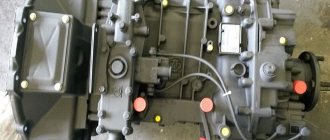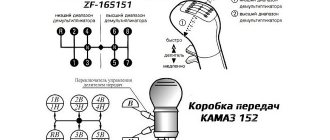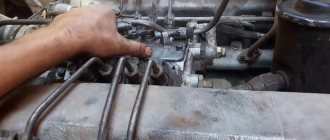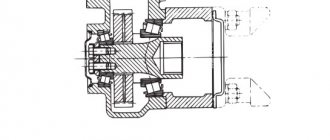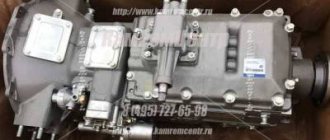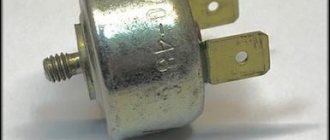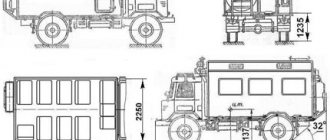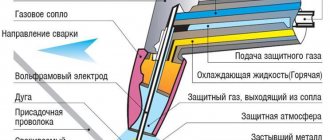A car's engine cooling system may include more than just an electric fan. An alternative to it is a mechanically driven cooling device - a viscous coupling, or viscous coupling. It smoothly changes the number of fan revolutions based on the temperature of the air flow passing through the radiator. Makes the cooling system more efficient under different operating conditions. Promotes timely warming up of the engine, cooling, maintains an optimal temperature for the operation of the engine and other machine components.
The site presents Hottecke viscous couplings for the cooling system of trucks, as well as impellers or assembled devices, completely ready for installation.
Design and principle of operation
Viscous coupling is a mechanical device of the engine cooling system that transmits torque through a working medium - a liquid with high viscosity. In Hottecke viscous clutches for trucks, the working medium is Dow Corning methyl silicone oil.
Main parts of the viscous coupling:
- Sealed housing;
- Drive disk mated to the drive shaft and connecting flange;
- Valve and control sensor.
The temperature sensor that controls the valve exists in several versions.
- bimetallic plate. Consists of two metal plates with different linear expansion coefficients. When the temperature rises to a given parameter, the plates bend and move the viscous coupling valve.
-thermospiral. This is a spring in the form of a spiral, one end of which is fixed in the coupling body, and the second is connected to the valve. When heated, the metal of the spiral expands and turns the clutch valve rod, opening or closing it.
-solenoid valve. This is a device that is connected to the vehicle's control system. The engine temperature sensor transmits a signal when the engine temperature rises beyond the operating range to the ECU (electronic control unit). The ECU, in turn, commands the clutch solenoid valve to close or open.
The clutch housing and drive disk are located close, but do not touch each other, coaxially.
Thanks to the viscous working fluid, friction is created between them and torque is transmitted from the drive disk to the housing on which the impeller is mounted. Although there will always be some degree of slip between them, the coefficient of friction created is sufficient to engage the clutch housing with the drive plate.
Using special notches at an angle (they act as a pump) at the end of the drive disk, the oil leaves the working area and is pumped into the reserve chamber. Then the clutch disengages.
When the temperature is within normal limits, the sensor closes the valve and the liquid does not move, it is in the reserve chamber.
When the temperature rises, the sensor causes the valve to operate. The working fluid enters the working area between the drive disk and the housing, due to which one element adheres to another. Then the clutch housing does not slip, its rotation speed increases, and, accordingly, the number of impeller revolutions increases.
Viscous couplings for trucks
Our website presents viscous couplings with a spiral and bimetallic sensor. For KAMAZ, MAZ, GAZ, URAL, KrAZ trucks. And also for PAZ, KAVZ, LiAZ, Ikarus buses.
When choosing, take into account not only the make of the car, the type of sensor, but also the diameter of the device, at what temperature it turns on and off, and the direction of rotation.
To quickly find the desired coupling and view the technical characteristics of the devices, use the search on the website. Click on the “Selection of spare parts” button, indicate the type of spare part, car make and engine type. Click on "Find".
Please note that in addition to viscous couplings, we have separate fan impellers for trucks of different brands, as well as viscous coupling assemblies.
The devices are stored in a horizontal position with the flange up, and in a vertical position - as they are installed on the engine.
Impellers
Rotating parts with blades are integral elements of fans. They create air flow. Which is supplied to the engine cooling radiator.
On the website you will find Hottecke fan impellers with 9, 10, 11 blades, with and without shells, of different diameters. The impellers are made of PA6 GF 30 plastic. Highly durable, resistant to temperature changes, and flame retardant.
Where to buy viscous couplings
You can buy a coupling without an impeller for a KAMAZ vehicle or other truck, as well as one impeller or an entire viscous coupling assembly in the stores of our partners. Wholesale or retail. Official representative offices of Hottecke operate throughout Russia.
You can also place an order online in any of our partner online stores presented on the website. With delivery anywhere in Russia.
How does it work
Operating principle of hydraulic coupling:
- The running engine drives a pump-type wheel.
- The working fluid, which is located in the space between the blades, begins to spin and is then thrown away from the rotational axis to the periphery of the wheel mechanism.
- The liquid gains kinetic energy and speed. It moves in the same direction as the pump wheel.
- After this, the working fluid is shifted from the pump wheel to the turbine wheel mechanism.
- In the space between the blades, fluid particles begin to influence the turbines, causing them to rotate at angular speed. During this rotation, the fluid particles transfer their kinetic energy to the turbine wheel.
- The liquid moves to the periphery of the turbine mechanism, after which it returns to the pump wheel.
- The whole process is repeated again, circulating in the space between the blades.
- The fluid coupling activates the fan, which begins to blow on the radiator, cooling the working fluid.
- When the oil temperature drops, the clutch switch is activated and the fan stops running.
If the fan does not turn on, it is necessary to inspect the clutch mechanism for damage.
A little about the use of viscous couplings
Today, viscous couplings in the automotive industry are used in only two cases, and the first one is still relevant, but it is also being gradually abandoned. So:
- For cooling the internal combustion engine . The very viscous fan couplings that this material is devoted to can be called a vanishing technical solution. Everything is arranged extremely simply: a coupling with a fan driven through a belt drive is attached to the rod. The system itself performs well in winter, but in summer the viscous fan couplings perform not so well. They are being replaced by electronic fans working in tandem with a special sensor;
- To connect all-wheel drive . As practice shows, today in 70 or even 80 percent of crossovers, viscous couplings are installed, which are responsible for connecting all-wheel drive in automatic mode. But they are also gradually being replaced by electromechanical devices.
Spare parts for Hafei princip
PRINCIP/SAIBAO sedan (05 — )
Spare parts for Audi 80
80 sedan (89, 89Q, 8A, B3) (06.86 - 10.91)
Why do viscous couplings remain relevant in general? There are several reasons:
- They are simple and very reliable;
- Viscous couplings are quite cheap. More complex electromechanics are more expensive for automotive component manufacturers;
- They are very durable. The device body can easily withstand pressure from 15 to 20 atmospheres . There are often cases when a car with a viscous coupling is sold after 7 years of operation and its new owner does not face the problem of device failure for many years to come.
However, there are also disadvantages. For example, viscous couplings are not very repairable. The descriptions for these devices say almost in plain text that they are disposable and, in general, their repair is impractical. In addition, such devices are not designed for long-term operation, although practice shows that they can work for a very long time - a pleasant exception to the rule. If viscous couplings are used in the drive, the system turns out to be not very effective - the maximum torque is transmitted only when the front wheels slip strongly, connecting the drive manually becomes impossible, etc.
Şərh • 124
Hello, is it possible to change the fluid coupling seal without removing the radiator?
Very inconvenient, but possible!
Generally called a clamping plier with a lock. I don’t know about you, but our people call it “bulldog” for short)))
Hello fime iz gruziii
Fima drink, you're not a drunk
There is a lot of left-wing talk. Essentially guys.
@Zheka Saltovsky there is no time to read books either. A. your job of replacing the oil seals, which was done in 20 minutes, lasted almost an hour.
Essentially in books only!
Yes, there would be fewer swear words or eliminate them
Guys, the KAMAZA engine was born snotty no matter what you do to it, but you have to do it always and everywhere, at home and on the roadside and everywhere, this is such a car and I always removed the radiator myself without any winches, 4-row
These “nippers” are called Third Hands, sort of!)
Zheka, how much does it cost to change the seals on the fluid coupling?
I have a Yamz 238, a cab with spacers, it folds up perfectly, you can jump high into it!
How to contact you. Do you have any questions about KAMAZ??
Film Fima, this is walking content!))) Hello to him)
hello! Hello to all subscribers! Evgeniy, if it’s not difficult, tell me the numbers of the wheel bearings (rear, front, internal, external) KamAZ 5511 91 year. Thank you)
I've had this belt for 2 years.
The oil seals on the fluid coupling can be changed without removing the rodator.
So I didn’t watch the entire video, I said)))
cool vidos but Feldman Park does not change the same tigers and that jeep I forgot when I went to visit my brother in Kharkov but Gepa you are great even Kiev is far from you good luck to you Kharkochans the first capital of Ukraine from Zaporozhye hello to you
Changing the fan clutch with your own hands
0 January 21, 2016
- Changing the fan clutch with your own hands
- Operating principle of the fan clutch.
- Fan clutch device.
- Replacing the fan clutch.
When an internal combustion engine operates, a large amount of heat is generated, the engine heats up, and there is a need for cooling in order to avoid its failure.
In most cases, the coolant (in addition to the air flowing around the engine) is a special coolant. The liquid, circulating through the engine channels, picks up heat and transfers it to the radiator, in which it is cooled, partly by the incoming air flow, and mainly by the fan. There are mainly two types of cooling used on cars: air and combined (liquid-air). In both cases, a fan is used for cooling. To remove large dynamic loads from the fan, vibrations and noise effects, as well as to maintain the required rotation speed, depending on the coolant temperature, a clutch is used.
Operating principle of the fan clutch.
Fan couplings are divided into: elastic, friction, electromagnetic, hydraulic, viscous couplings.
An elastic coupling, through the rubber parts of two contacting disks, transmits torque from the drive disk to the driven disk, to which the fan is attached. When the engine abruptly switches from one mode to another, shock loads are absorbed due to the elasticity of the rubber that connects the driven and driven disks. The fan constantly rotates due to a V-belt transmission from the fan drive gear to its pulley.
Design and principle of operation
When a car engine is running, the oil heats up along with the parts. The more powerful the engine, the more heat is generated and the higher the oil temperature rises. When the limit values of this parameter are reached, the properties of the lubricating fluid are lost, which leads to failure of the elements and the entire motor. Heat exchangers are used to remove excess heat from the oil in the lubrication system.
KamAZ trucks are equipped with shell-and-tube (tubular) LMCs. They consist of a cast aluminum body and core. The latter is a bundle of thin-walled tubes, in most cases copper, flared into flanges, which at the same time serve as end caps for the oil cavity. To increase the heat transfer area, the outer side of the tubes has fins made in the form of plates.
Cooling system antifreeze circulates inside the tubes. Oil is supplied through flanges into the heat exchanger housing. Thanks to the installed partitions, it crosses the tube bundle 4 times, which greatly increases the efficiency of cooling the medium. Due to the fact that the oil temperature cannot be lower than the temperature of the cooling system fluid, this reduces the thermal stress of the lubricated parts.
The heat exchanger is installed on the housing of the filter unit. It contains a thermal valve (thermostat) for connecting the heat exchanger. At a temperature of +93°C and below, the main flow of oil passes by the liquid solids. Increasing the parameter above +95°C leads to movement of the thermal valve piston. The flow of working fluid from the lubrication system is directed to the heat exchanger. At a temperature of +115°C, the oil overheats, which is indicated by a red indicator located on the driver’s instrument panel. After this, the machine must be stopped and measures taken to bring the parameter values back to normal.
Role in the internal combustion engine cooling system
A viscous coupling fan is installed on vehicles with a longitudinal engine (usually all-wheel drive and rear-wheel drive models). With this arrangement, it is most advisable to connect the radiator fan pulley to the water pump pulley. As you know, rotation of the water pump is transmitted by a service belt from the crankshaft pulley.
The disadvantage of this design is that the rotation speed of the fan impeller will always be proportional to the crankshaft speed. Such a device will result in the engine being excessively cooled at high speeds in cold air conditions, which will reduce its efficiency. In addition, the permanent connection of the impeller and the crankshaft pulley will increase mechanical friction losses, which will take away power and increase fuel consumption.
The viscous fan coupling allows you to adjust the rotation speed of the impeller depending on the engine temperature.
Device
The difference in the design of viscous fan couplings for Toyota, BMW, Mercedes, Audi. is minimal, since they are all designed and work according to the same principle.
Design
A dependent wheel is installed in the casing cavity, which also looks like a torus, located with a flat side in relation to the main wheel. In each internal cavity of the wheel there are special blades placed around the circumference of the original shape. The wheels have a solid cast structure, which significantly increases the strength of the structure. There are 33 blades in the main wheel, and 32 in the dependent wheel. There is a small gap in the middle of these wheels, which makes it possible to introduce engine oil and remove residues. The working space of the coupling is formed by a cavity between the wheels and internal planes turned towards them.
The driven shaft with the corresponding wheel is fixed in a rigid manner. The shaft passes through the free space in the central part of the main wheel. The end of the shaft is located on the hub. The KAMAZ fan impeller is secured with bolts. This solution makes it quite easy to dismantle the part during repairs. The dependent shaft rests on bearings on both sides.
The assembled unit is mounted on the front cover. The fluid coupling must be located coaxially with the engine crankshaft.
The drive pulley and hub are fixed on the outside. The part is protected from the inside by a cover where the bearing supporting the main shaft is located.
The basis of the regulator is a housing where several oil channels, valves, a KAMAZ fan sensor and a thermal power value sensor are installed, which changes its size based on temperature data. This unit is located on the cylinder block on the right side. Through the inlet pipe, the antifreeze liquid enters the water jacket, where it drops to a minimum temperature. The oil passages are connected to the main oil pipeline, which operates in conjunction with the discharge section.
Purpose of the fluid coupling and its role in the cooling system
The fluid coupling has several undoubted advantages and disadvantages over the viscous coupling and electric fan drive, which determines its wide distribution. Compared to a viscous coupling, a fluid coupling works more reliably and efficiently; it switches on and off more clearly, ensuring reliable cooling of the radiator. And compared to an electric drive, a hydraulic clutch makes an entire electrical circuit with its fuses, relays, sensors and wiring unnecessary. At the same time, the more complex design of the fluid coupling is fully compensated by its reliability and efficiency, which are not available to the viscous coupling and electric motor.
The hydraulic coupling performs several functions:
• Power take-off from the crankshaft to the fan; • Smooth connection and disconnection of the cooling fan from the crankshaft; • Damping of loads and reactive moments that arise when the fan is connected and disconnected, as well as when the operating mode of the power plant changes.
However, it should immediately be noted that the fluid coupling itself is an ineffective unit; it can normally perform its functions only in conjunction with a regulator-switch. This unit controls the operation of the hydraulic coupling and solves several problems:
• Turning the fan on and off automatically when the threshold temperature is reached; • Constant turning on or off of the fan, regardless of the degree of heating of the motor; • Ensuring optimal impeller rotation speed depending on the current temperature of the power plant.
Working in pairs, the clutch and regulator control the operation of the fan and the entire diesel cooling system as a whole. So these nodes play an important role, but at the same time they are not complicated or expensive.
Troubleshooting
Kamaz is a reliable tractor produced by the Kama Machine-Building Plant, which has enjoyed unprecedented popularity for many years, occupying a leading position on Russian roads. In addition to a long service life, it has a large supply of operating resources, inexpensive consumables, and simple maintenance. That is why it will not be difficult to replace faulty fluid coupling parts.
- The first among possible breakdowns is the switch - the most short-lived spare part.
- The main consumable is oil. The manufacturer recommends using all-season oils to avoid thickening in winter.
- It is always necessary to carry out a visual inspection for leaks.
- Antifreeze must always be topped up to a certain level, indicated on the tank with special strokes. If you add more, the antifreeze will boil away, foam, or overflow under the influence of high temperatures; if you do not add enough, it may not be enough for productive work.
- Deterioration in clutch performance can be determined by a decrease in the number of revolutions.
Preventative maintenance for the cooling system is carried out extremely rarely. As a rule, this unit operates smoothly for about fifty thousand kilometers, but much depends on the operating conditions of the vehicle.
Scheduled maintenance is a regular visual inspection to identify leaks, smudges, leaks, constant oil changes, and adding antifreeze. You should also constantly check the serviceability of the switch, otherwise a breakdown may occur at the most inopportune moment.
